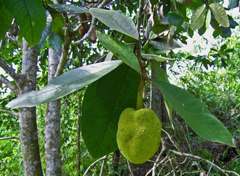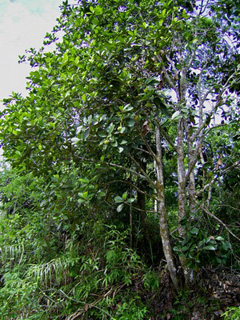 |
|
wikimedia.org User:W.A.Djatmiko |
 |
| wikimedia.org User:W.A.Djatmiko |
Translate this page:
Summary
Artocarpus odoratissimus, otherwise known as marang, terap, timadang, johey, oak, green pedalai, tarap, or madang, is a large, tropical, evergreen tree. It is native to the Philippines, particularly in Palawan and Mindanao, and Borneo. It can grow up to 25 m high and its trunk can reach up to 50 cm in diameter. It is known for its sweet, fleshy, and juicy fruits that are said to be superior to the jackfruit and cempedak. Ripe fruits are eaten fresh and immature fruits are cooked as vegetables. The seeds are either consumed roasted or boiled. The latex obtained from the tree is used for treating inflammation from wounds. The leaves are large and sometimes used as thatch. The wood can be used for light constructions, box-making, and crates.
Physical Characteristics

 Artocarpus odoratissimus is an evergreen Tree growing to 25 m (82ft) by 20 m (65ft) at a medium rate.
Artocarpus odoratissimus is an evergreen Tree growing to 25 m (82ft) by 20 m (65ft) at a medium rate.
See above for USDA hardiness. It is hardy to UK zone 10.
Suitable for: light (sandy), medium (loamy) and heavy (clay) soils and prefers well-drained soil. Suitable pH: mildly acid, neutral and basic (mildly alkaline) soils. It cannot grow in the shade. It prefers moist soil. The plant is not wind tolerant.
UK Hardiness Map
US Hardiness Map
Synonyms
Artocarpus mutabilis Becc. Artocarpus tarap Becc.
Plant Habitats
Edible Uses
Edible Parts: Fruit Seed
Edible Uses:
Edible portion: Fruit, Seeds, Nuts. The ripe fruits are fleshy, aromatic, sweet and juicy - similar to the jackfruit (A. heterophyllus) but of much better quality[ 46 , 301 ]. Usually eaten as a dessert fruit, they are considered to be the finest fruit in Brunei[ 301 ]. The unripe fruit can be eaten as a boiled vegetable[ 301 ]. The roundish to oblong fruit is quite large, averaging about 16cm long and 13cm in diameter[ 306 ]. The rind of the fruit is said to be edible[ 301 ]. Thick and fleshy[ 306 ]. Seed - roasted or boiled and eaten[301,306]. Seeds boiled for 30 minutes in salty water have a delicious nutty flavour[ 303 ]. Roasted seeds have a flavour similar to sweet chestnuts[ 416 ]. The whitish seed is about 8 _ 15mm in size[ 306 ].
References More on Edible Uses
Medicinal Uses
Plants For A Future can not take any responsibility for any adverse effects from the use of plants. Always seek advice from a professional before using a plant medicinally.
None known
References More on Medicinal Uses
The Bookshop: Edible Plant Books
Our Latest books on Perennial Plants For Food Forests and Permaculture Gardens in paperback or digital formats.

Edible Tropical Plants
Food Forest Plants for Hotter Conditions: 250+ Plants For Tropical Food Forests & Permaculture Gardens.
More

Edible Temperate Plants
Plants for Your Food Forest: 500 Plants for Temperate Food Forests & Permaculture Gardens.
More

More Books
PFAF have eight books available in paperback and digital formats. Browse the shop for more information.
Shop Now
Other Uses
References More on Other Uses
Cultivation details
A plant of lowland humid tropics, succeeding at elevations up to 1,000 metres[ 200 , 303 ], it grows best in regions with abundant and equally distributed rainfall[ 306 , 525 ]. Prefers a deep, well-drained soil[ 200 ]. Young plants need some shade, but need increasing light levels as they mature[ 200 ]. Trees as young as 4 - 6 years can begin to bear fruit[ 303 ]. Yields of 4 - 6 tonnes per hectare have been achieved[ 303 ]. The fruits are borne at the end of long flexible branches and ripe fruits are heavy, fragile and difficult to reach for harvest[ 303 ]. Mature fruits are usually harvested by hand with the help of a curved knife attached to the end of long bamboo pole[ 303 ]. Getting at the heavy fruit at the end of slender twigs is hazardous[ 303 ]. The delicate fruit really should be caught to break the fall, it has a very short shelf life[ 303 ]. A tree produces about 180 fruit per season.
References Carbon Farming Information and Carbon Sequestration Information
Temperature Converter
Type a value in the Celsius field to convert the value to Fahrenheit:
Fahrenheit:
The PFAF Bookshop
Plants For A Future have a number of books available in paperback and digital form. Book titles include Edible Plants, Edible Perennials, Edible Trees,Edible Shrubs, Woodland Gardening, and Temperate Food Forest Plants. Our new book is Food Forest Plants For Hotter Conditions (Tropical and Sub-Tropical).
Shop Now
Plant Propagation
Seed - it has a short viability and so is best sown as soon as it is ripe[ 200 , 303 ]. The seed germinates best at a temperature of 24 - 27c[ 200 ]. Germination is often 100% within 4 weeks[ 303 ]. Plants are spaced 12-14 m apart. Root cuttings. Air layering. Plants can be grafted.
Other Names
If available other names are mentioned here
Artocarpus odoratissimus, otherwise known as marang, terap, timadang, johey, oak, green pedalai, tarap, or madang. Other Names: Marang, Beluli, Kian, Muntorong, Pingan, Tarap, Terap, Pi-ien, Keiran, Loloi, Morang, Marang-banguhan, Timadang, Keiran, Pingan, Tekalong, Benturung, Jarap hutan.
Native Range
TROPICAL ASIA: Indonesia, Kalimantan, Malaysia, Sabah, Sarawak,
Weed Potential
Right plant wrong place. We are currently updating this section.
Please note that a plant may be invasive in one area but may not in your area so it's worth checking.
None Known
Conservation Status
IUCN Red List of Threatened Plants Status : This taxon has not yet been assessed.

Growth: S = slow M = medium F = fast. Soil: L = light (sandy) M = medium H = heavy (clay). pH: A = acid N = neutral B = basic (alkaline). Shade: F = full shade S = semi-shade N = no shade. Moisture: D = dry M = Moist We = wet Wa = water.
Now available:
Food Forest Plants for Mediterranean Conditions
350+ Perennial Plants For Mediterranean and Drier Food Forests and Permaculture Gardens.
[Paperback and eBook]
This is the third in Plants For A Future's series of plant guides for food forests tailored to
specific climate zones. Following volumes on temperate and tropical ecosystems, this book focuses
on species suited to Mediterranean conditions—regions with hot, dry summers and cool, wet winters,
often facing the added challenge of climate change.
Read More
Expert comment
Author
Blanco
Botanical References
Links / References
For a list of references used on this page please go here
A special thanks to Ken Fern for some of the information used on this page.
Readers comment
| Add a comment |
|
If you have important information about this plant that may help other users please add a comment or link below. Only comments or links that are felt to be directly relevant to a plant will be included. If you think a comment/link or information contained on this page is inaccurate or misleading we would welcome your feedback at [email protected]. If you have questions about a plant please use the Forum on this website as we do not have the resources to answer questions ourselves.
* Please note: the comments by website users are not necessarily those held by PFAF and may give misleading or inaccurate information.
To leave a comment please Register or login here All comments need to be approved so will not appear immediately.
|
Subject : Artocarpus odoratissimus
|
|
|
|